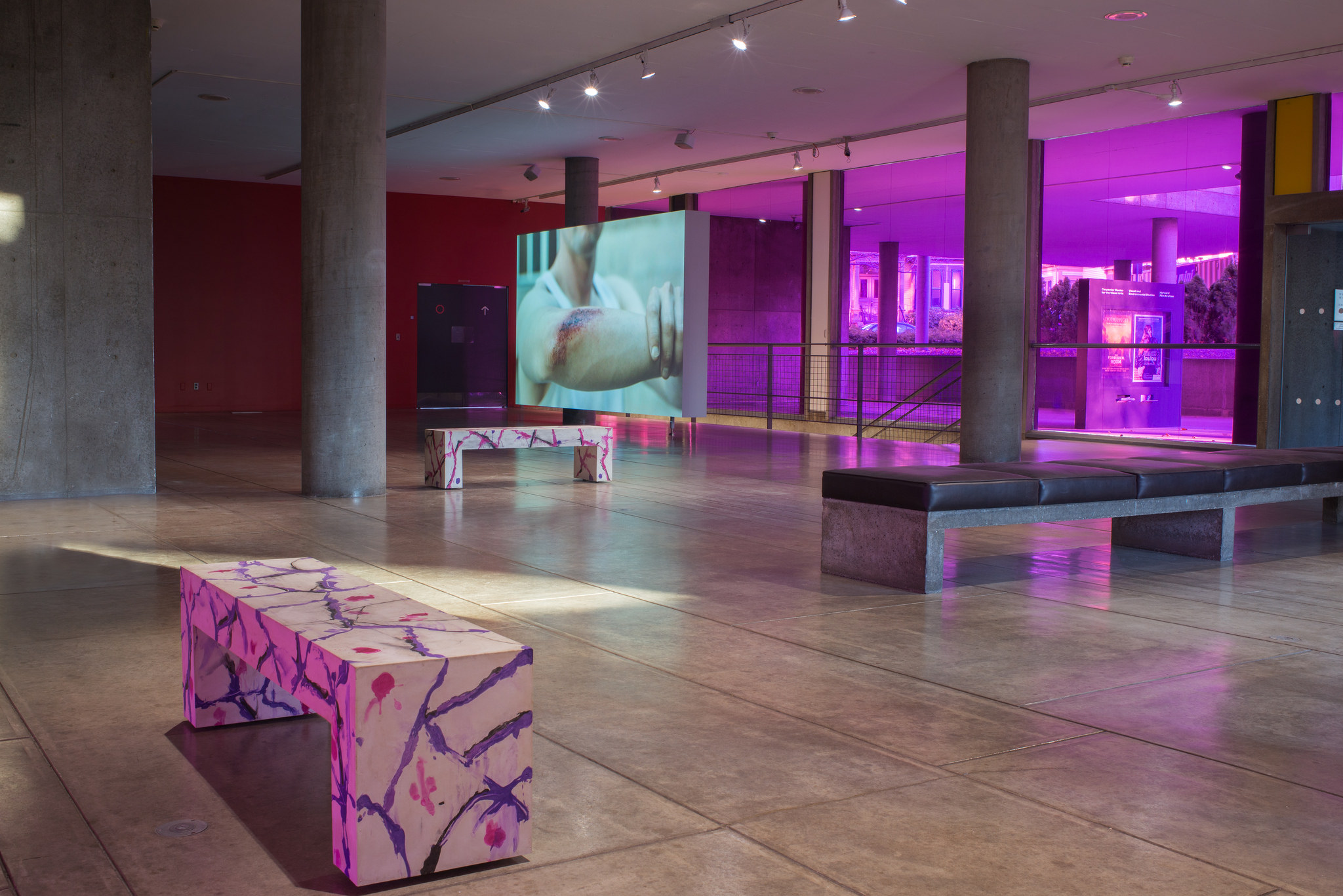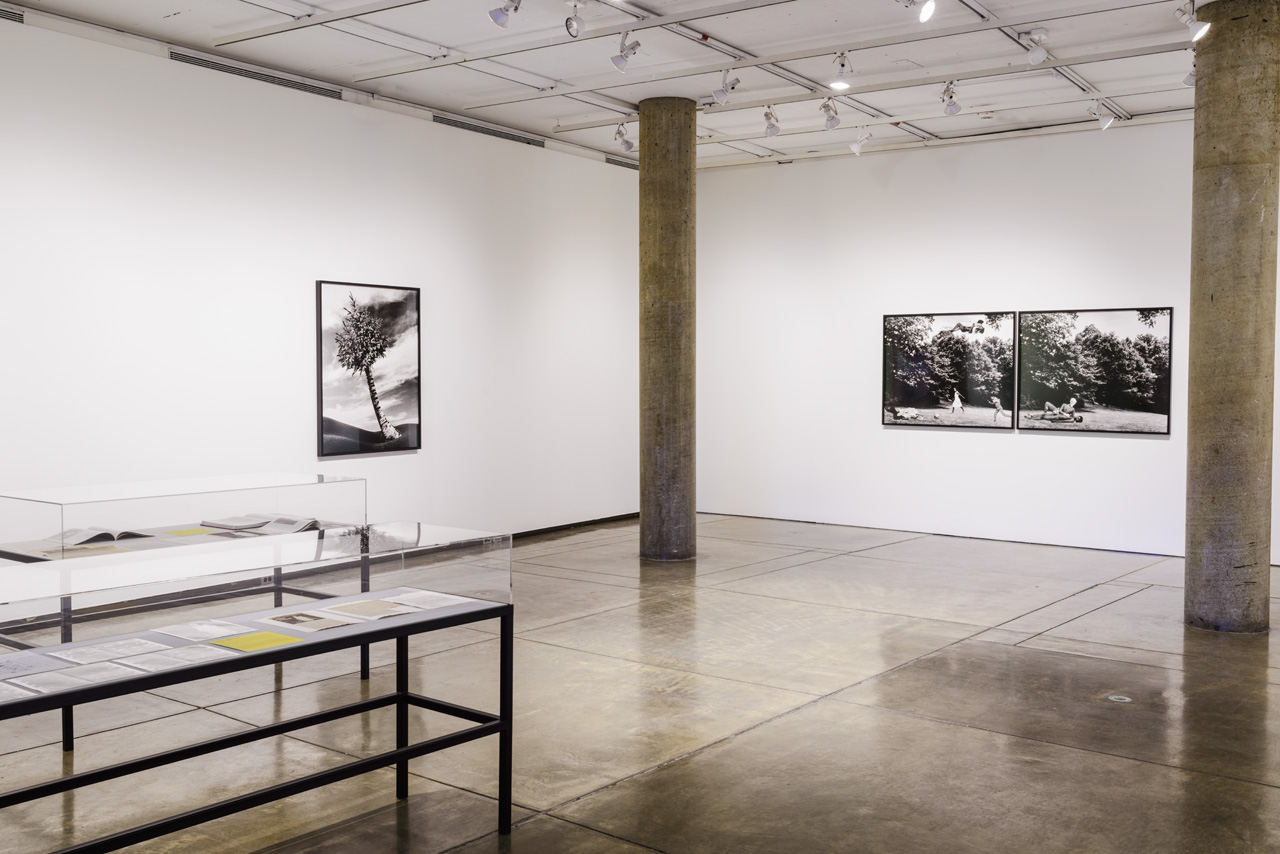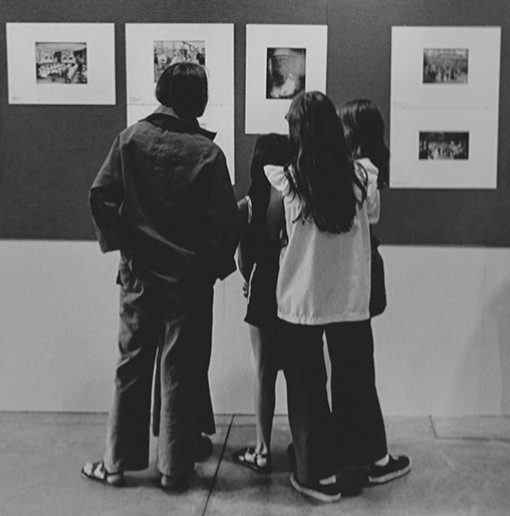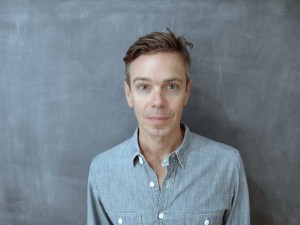This interview is part of the “Boston Common” series that highlights the people and institutions that shape Boston and New England’s culture sector. It features a discussion of Voorhies’s new role as the John R. and Barbara Robinson Family Director of the Carpenter Center at Harvard University, programming at the Carpenter Center, and its place in the Greater Boston arts scene. This interview was edited for clarity.
Lisa Crossman: How would you explain the Carpenter Center to someone who’s never heard of it?
James Voorhies: The Carpenter Center is an incredible building designed by Le Corbusier, completed in 1963 to become Harvard’s Visual Arts Center. Here, students from many different disciplines would study to sharpen their sensory awareness of the visual world. The University founders of the program had rather visionary goals. Students experimented with materials, color theory, study of typography, design, ceramics, photography, cinema and much more. Harvard wanted a unique program in the arts that would teach visual literacy. And they wanted an innovative building equal to their ideas. As you know, it’s the only building by Le Corbusier in North America. He thought it would be his entrée into a North American market, but passed away in 1965, shortly after it opened.
Today the Carpenter Center houses the Department of Visual and Environmental Studies (VES), an undergraduate program in the visual arts. There are studio courses in painting, sculpture, film, photography, as well as other courses in theoretical studies and contemporary art. It’s a liberal arts education that prioritizes making alongside thinking. The academic activities occupy a major part of the building. But it is also the site of public exhibitions and programs that I oversee. It has a beautiful cinema where students view films as part of their studies. The cinema and offices are on Level 0, which is also home to the Harvard Film Archive. The Carpenter Center is many things at once, and a little challenging to quickly summarize.
LC: The building presents specific opportunities, but also perhaps obstacles. Would you describe the challenges and opportunities of working in this building first, and then explain how these connect to various facets of the programs it houses?
JV: The building is kind of a beautiful problem. It’s not an easy architecture to understand or navigate. Even from the first encounter: where to enter? Up the ramp or down the steps? Questions about the building occupy every single discussion we have about programs, installations and exhibitions. It’s this hovering, omnipresent thing that we contend with each day. But it’s a fascinating experience to work here and deal with the vast open spaces, the walls of windows, and questions that come up. I’ve been here almost two years, and I’m still learning what the building can do and the potential it has for programs and exhibitions. I’m learning how to situate audiences in spaces so they’re more comfortable, trying to introduce an informality in programs that encourage them to visit repeatedly like we did this summer with the Summer Summits on the terrace. I’ve worked on how to move visitors into and through the building more easily, between different exhibition spaces with new design identity and wayfinding. I’ve also intentionally encouraged people from other disciplines and fields to visit the Carpenter Center. The performance last fall with Keith Fullterton Whitman as part of Damon Krukowski’s exhibition on an Ezra Pound recording in the Woodberry Poetry Room is one instance.
But the architecture certainly presents challenges to artists who need, rightly so, to stake a particular claim to the space so their work isn’t lost within the architecture. Shahryar Nashat’s current exhibition Skins and Stand-ins is a perfect example. In the many phone calls after Shahryar’s site visit leading up to his exhibition this fall, we considered numerous options for how best to present his video and sculptures. It was important that the architecture wasn’t just a space where his work would reside, but a space that spoke to a unified atmosphere, an environment that he as an artist could take ownership. We went through different scenarios, including covering the floor with a kind of linoleum or dance floor material. That was too expensive. Then he came up with an option—influenced by creativity and economics—to place translucent magenta filters on the large floor-to-ceiling windows. It feels so right in here because when visitors enter Level 1, they know something is different, they are disoriented in the best of ways and their eyes and bodies respond to this perplexing environment. So the architecture becomes momentarily Shahryar’s in a way. That’s important. Physically and sensuously, one sees and feels the unified character of his exhibition.

Shahryar Nashat: Skins and Stand-ins, October 29, 2015–January 10, 2016, Carpenter Center for the Visual Arts
LC: How does the building itself relate to your invitation to artists?
JV: While I appreciate many kinds of art, I often respond to artists who work across mediums and are inspired by critical questions, often making atmospheric conditions that might combine video, sculpture, and performance all in one work. Often these artists work spatially and the building, especially Level 1, encourages collaborations with these artists. Last year we launched the new program with a solo exhibition by Berlin-based artist Simon Fujiwara, who was initially trained as an architect. Simon couldn’t make a research trip before his exhibition. But even from a distance—through (many!) electronic exchanges of photographs and floor plans—it was clear he had a distinctive sense of the space. When he finally arrived for installation, he of course reconfigured many things, but he knew what he wanted and how to work with the objects, videos and installation in relation to how spectators would encounter the works and engage with them spatially—immersively. That’s so important because the arrangement of objects in a space is part of communicating the concept of artworks, thinking about sightlines and how spectators approach the work. I love that part of putting together exhibitions, the seductive and subtle way arrangement in relation to architecture impacts an experience without spectators even knowing it.

Lorraine O’Grady: Where Margins Become Centers, October 29, 2015–January 10, 2016, Carpenter Center for the Visual Arts
While the architecture influences exhibition making, it’s definitely not the only factor. We currently have a gorgeous exhibition of work by Lorraine O’Grady installed on Level 3 in the Sert Gallery. Eighty-one years old and a native of Boston, this is Lorraine’s first solo exhibition in the area. Our spaces are too modest in scale to mount major solo exhibitions, so I put together a precise selection of work that introduces her practice while focusing on her use of the diptych as a strategic means for critiquing the social forces affecting racial inequality and gender identity. I thought this would be a way to both present work and demonstrate to students how a practice is informed not by a singular medium but by important questions and critical thinking. So the difference between the two exhibition spaces provides nice opportunities for working differently with artists.
LC: You taught art history and also founded Bureau for Open Culture , a nomadic curatorial and publishing platform. How has your past professional experience informed your work here so far?
JV: Yes. As a curatorial practice, Bureau for Open Culture functioned in appearance as an institution. We made exhibitions; we made publications; we engaged audiences with objects and time-based activities—events. But, in actuality, something I increasing realized as years progressed was that Bureau for Open Culture was a kind of performance of institution, promising all those things an institution provides but not completely delivering what one expects, something else. By doing so, we played with expanding the potential of how an institution engages with audiences and builds communities, inhabiting institution to critically reflect on institution and its potential in connecting with people and working with artists.
A good example is a project called I Am Searching for Field Character. We made this project at MASS MoCA. Bureau for Open Culture, which included my boyfriend Nate Padavick, who designed everything, and our collaborator Cassandra Troyan, who is a writer and artist, and many, many others who stepped in to work with us. Nate, Cassandra, and I were in residence for almost four months at MASS MoCA, working out of a small building on the museum’s campus. It was called Building 9 and originally stored the small transistors made by Sprague Electric (the industry that occupied MASS MoCA before it was a museum). We were invited by curator Susan Cross to be part of the exhibition she made called The Workers [May 29, 2011–Apr 14, 2012], which included works by contemporary artists with different perspectives on labor, generally speaking.
During the course of the exhibition, Bureau for Open Culture did many things. We collaborated with artists to run a goods market; hosted residencies with visiting artists and a landscape architect; made short-run exhibitions and organized performances. We used the space as a studio and workshop. We operated a beer garden as a form of economy (although we made no money) and to think about the service industry within the cultural economy. The beer garden was a beer garden, open Thursday to Saturday for the summer months. The beer garden was also a bit of a thorn to MASS MoCA because it challenged what was possible at the museum in terms of licenses, food permits (we sold soft pretzels)—questions about how visitors without paying entry could reach us behind the museum (everything Bureau for Open Culture did was free, while entrance to the museum cost). The beer garden was a means to reflect on the role of consumerism in relation to the value consumer points, or more obvious consumer experiences have for bringing people together; it was kind of a gateway to our programming. It was a net. I’m interested in how we consume experiences that move between or overlap with consumption of commercial goods and, one might say, culture. It’s all meshed up today into one total consumer experience at museums. So important questions for me are how to inhabit these known and appealing quantities—a beer garden, coffee bar, a bookshop—and turn them into advantages for the institution to connect with audiences in meaningful ways.
I’ve been interested for a while in questions around modes of consumption at art institutions, especially in relation to building audiences and how consumer activity can add to an institution’s program. I’m super excited about a new program at CCVA that we will launch at the end of February. It’s called Consumer Research Center/. It’s an initiative that intends to perform and reflect upon consumerist outlets as points of sociability in 21st-century arts organizations and think about the hybridization of cultural, social and economic activities characterizing our lives and work today. The first iteration is Consumer Research Center/bookshop, a collaboration with Motto Books in Berlin.
LC: So how does it work?
JV: We will open a bookshop on Level 3 in the Sert Gallery area, overlooking the terrace. It will have regular hours just like the gallery. The bookshop will be a bookshop with amazing titles by artists, writers and institutions from around the world, many unavailable anywhere in Boston and possibly even the East Coast. The bookshop, like a beer garden, will be a net. It will without a doubt stop people passing by the doors on Level 3 who might otherwise keep walking. It’s a gateway for introducing our program. CRC/bookshop will also be a place for events, performances and talks with visiting artists and writers, filmmakers, scholars and our colleagues in departments around Harvard and at arts and academic institutions in the area. Consumer Research Center/ will become an integral part of the identity of the Carpenter Center.
LC: Your role as both a curator and the Director of the Carpenter Center demands a layered way of having to speak about the institution, to be critical of it and promote it, and to be conscious of how you’re weaving this narrative for multiple audiences. How do you do this?
JV: I enjoy working with artists in many different capacities, whether presenting existing work, creating a publication, solving problems, or commissioning a new installation or project. At the Carpenter Center we want all our audiences—including students, nearby residents, those visiting occasionally for a program, and even those viewing online from a distance—to leave with more than they entered. I hope the programs and exhibitions we present balance both rigor and approachability, permeability. They can be entertaining, while asking more questions than they answer. We place a lot of value on our relationships with artists and tend to work repeatedly with some, such as Martin Beck and Fernanda Fragateiro who have made many visits to Harvard. This makes sense to me because there remains so much to know and discover even after audiences encounter a singular work or hear a public talk. Fernanda is a great example. We showed her work in the Modernist Ideologies exhibition last spring, and she later returned to do a program connected with a course in the Materials Lab at the Harvard Art Museums. The Museums ended up acquiring a work related to that visit. And she will return again this spring to research for a future project with me at the Carpenter Center.
LC: I think that’s a nice aspect of your programming. It’s intriguing to see a continued dialogue with an artist.
JV: Yes. Fernanda is one example. Martin Beck is another. The program you mention is called Institution (Building). It’s something I conceived shortly after I started working at CCVA. Institution (Building) is a biennial invitation to an artist to be here on an intermittent basis over the course of two years to reflect on the history, pedagogical initiatives, the modernist architecture—whatever they’re attracted to. Martin is the first artist, and it’s been the most incredible experience because he has delved into the archive, looking at different modes of exhibition displays and academic goals that were originally set for the Visual Arts Center. I have learned so much from Martin by his pointing my attention in certain directions and through long conversations about the character of this deeply complex building and program. Martin’s time with us will conclude around July 2016. We’re currently thinking about the next artist to invite to the Institution (Building) program.
LC: Have you been part of the discussions about the role of art in Greater Boston, the role of artists, and how the city can support the arts that Julie Burros has initiated?
JV: No. I would really like to be involved. I think it’s tricky for many cities. Even the fact that the arts have to “function” is problematic in my mind. Everything actually functions, of course, but I am weary of the instrumentalization of the arts because it is the appearance of uncertainty and confusion that allows art to be art. So once it begins to function more concretely with a defined outcome, well, it begins to look more like design, or social work, or something else. Art is having a difficult time as art anyway.
LC: I actually worry about this as well. I see the value of embedding artists in city government, for instances. I think it’s an interesting idea and could be an asset, but then I worry that the side effect of this is that most people still will not value artists for actually producing work for the purpose of looking and thinking. There’s something very valuable in the moment of pause and aesthetic contemplation that happens when you look at art.
JV: Do you think education programs are changing because of institutions like city governments and others that are placing greater onus on art to be something else?
LC: That’s a good question. I think art education programs are also in a state of crisis (especially as costs of programs soar). I’ve been thinking about the panel discussion on art education that I read in Artforum and about Luis Camnitzer’s comments on art education when he spoke here in October. He was commenting that art education should not be just about craft; art making is thinking and that is important to everyone in a liberal arts education sense. We all benefit from thinking, reading and discussing broadly, being problem solvers, practicing creativity, etc. This is tied to the embedding of artists in that it recognizes and supports artists as key individuals who think expansively, critically and creatively. These skills are crucial to art making and education, and are important skills for everyone.
JV: Absolutely. The program here was actually built with the expectation of the acts of making and thinking as integral parts of being an artist. That’s part of my attraction to the artists we work with. Not all of them, but most of them, would define their practice not through a single medium, but a strong conceptual inquiry.
LC: This brings me back to the archive and its significance at the Carpenter Center. The archive has an added presence here. What is your interest in the archive generally and thoughts on its role here?
JV: The photos of activities and exhibitions in the early days reveal an astounding creativity to display and a wonderful thinking through of ways to use the architecture. And photography was used for both exhibition and as a learning tool to discuss things like light, composition and communication. Martin has pointed our attention to this history many times, and we actually open an exhibition by him in late January as a welcome back to students and faculty. His exhibition is called A Social Question and is based on a 1973 exhibit titled The Social Question: A Photographic Record 1895–1910 that included a selection of photographs from the Social Ethics Collection collected by Francis Greenwood Peabody, founder of the Social Ethics Department at Harvard. The photographs were a learning tool to introduce students and visitors to all sorts of social questions around labor reform and immigration—topics that remain incredibly urgent today.

Installation view of The Social Question: A Photographic Record 1895–1910, 1973. Carpenter Center for the Visual Art, Harvard University
LC: So what does this rich history mean to the contemporary moment?
JV: I think as this building and program continued to define itself in the 1960s, faculty, students, and staff undertook informal social activities like coffee hour on Level 1. There are stories about coffee and smoking in the lobby. That sounds nice. It’s an institution behaving not how an institution is supposed to behave. We could use more of that activity. Unfortunately, I think as time progressed from the early days, when they really knew how to use this building, into the 1990s, a formality set in where exhibitions took on much more complex, self-conscious, staid layouts like a white cube.
One learns from history how to live in the present moment, if one is paying any attention. I look at photographs and films of students and faculty in this building in the 1960s and 1970s and the beautiful informality, messy and creative approaches they applied, nestling into the space, socially and exhibition-wise, and I see how the archive can teach us a lot about how to be more informal and free. It can teach us to be open in our circulation and inhabitation of this architecture, whether Le Corbusier wanted it that way or not.





1 Comment
I am honored to say that I was Lisa Crossman’s art teacher at U32 High School in Vermont. She was one of my all-time favorite students and a cherished friend. What a great person. And I am so impressed with her career path and her role in this article. The whole conversation with Mr. Vorhees was intriguing and compelling, about of thinking, and behaving and making art. I am refreshed and grateful. So glad I saw her name and read on…and on……